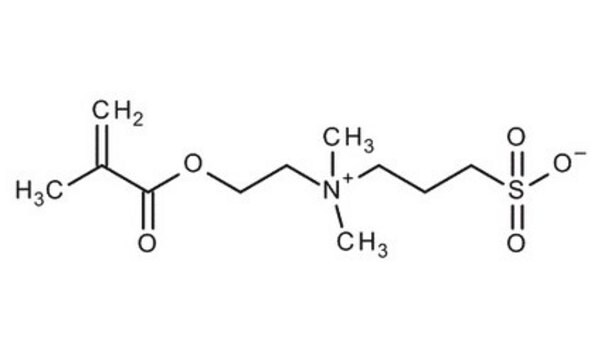N0665
NDSB 211
≥98% (TLC)
Sinonimo/i:
3-[Dimethyl-(2-hydroxyethyl)ammonio]-1-propanesulfonate, Dimethyl(2-hydroxyethyl)(3-sulfopropyl)ammonium hydroxide inner salt, Dimethyl-2-hydroxyethylammoniumpropane sulfonate
About This Item
Prodotti consigliati
Descrizione
zwitterionic
Saggio
≥98% (TLC)
Forma fisica
solid
PM
211.28 g/mol
tecniche
DNA extraction: suitable
Colore
white
Solubilità
methanol: 5 mg/mL, clear, colorless
Stringa SMILE
OCC[N+](C)(C)CCCS([O-])(=O)=O
InChI
1S/C7H17NO4S/c1-8(2,5-6-9)4-3-7-13(10,11)12/h9H,3-7H2,1-2H3
CNXPCGBLGHKAIL-UHFFFAOYSA-N
Descrizione generale
Applicazioni
Altre note
Avvertenze
Danger
Indicazioni di pericolo
Consigli di prudenza
Classi di pericolo
Skin Corr. 1B
Codice della classe di stoccaggio
8A - Combustible corrosive hazardous materials
Classe di pericolosità dell'acqua (WGK)
WGK 3
Punto d’infiammabilità (°F)
Not applicable
Punto d’infiammabilità (°C)
Not applicable
Certificati d'analisi (COA)
Cerca il Certificati d'analisi (COA) digitando il numero di lotto/batch corrispondente. I numeri di lotto o di batch sono stampati sull'etichetta dei prodotti dopo la parola ‘Lotto’ o ‘Batch’.
Possiedi già questo prodotto?
I documenti relativi ai prodotti acquistati recentemente sono disponibili nell’Archivio dei documenti.
I clienti hanno visto anche
Il team dei nostri ricercatori vanta grande esperienza in tutte le aree della ricerca quali Life Science, scienza dei materiali, sintesi chimica, cromatografia, discipline analitiche, ecc..
Contatta l'Assistenza Tecnica.![[2-(Methacryloyloxy)ethyl]dimethyl-(3-sulfopropyl)ammonium hydroxide 95%](/deepweb/assets/sigmaaldrich/product/structures/217/219/73c91e1c-0ee4-4b3d-bead-a6dc3d09d1da/640/73c91e1c-0ee4-4b3d-bead-a6dc3d09d1da.png)











